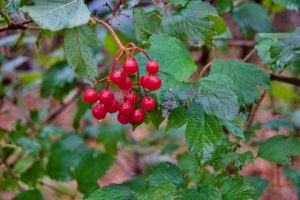highbush cranberry
Viburnum opulus var. americanum

Description:
The highbush cranberry is not a cranberry though its fruit looks and tastes like cranberries. It is part of the honeysuckle family, whereas the true (or low bush) cranberry is a member of the heather family.
Highbush cranberry grows in hardiness zones 2-7, is 8-15 feet tall and 8-10 feet wide. It tolerates frost and likes sun or semi-shade. This bush is successful in most soil types but does best in well-drained, moist soil that is rich and contains loam.
Use and Management:
This bush is a magnet for wildlife. It provides food for deer and birds. It can be used as a hedge by spacing plants 2-3 feet apart.
Additional Information:
highbush cranberry
| USDA Symbol: | Common Name: | Scientific Name: |
|---|---|---|
| VIOPA2 | American cranberrybush | Viburnum opulus |
ITIS TSN: 530811
Category: Dicot
Taxonomy
Kingdom: Plantae
Subkingdom:
Super Division: Spermatophyta
Division: Magnoliophyta
Subdivision:
Class: Magnoliopsida
SubClass: Asteridae
Order: Dipsacales
Family: Caprifoliaceae
Counties:
Active Growth Period: Spring and Summer
Bloat: None
Carbon to Nitrogen Ratio: High
Conspicuous Fall Color: Yes
Fire Resistant: No
Flower Color: White
Conspicuous Flower: Yes
Foliage Color: Green
Foliage Light Porosity Summer: Moderate
Foliage Porosity Winter: Porous
Foliage Texture: Coarse
Fruit/Seed Color: Red
Growth Form: Multiple Stem
Growth Rate: Slow
Height at Base Age (Max): 6
Known Alelopath: No
Leaf Retention: No
Lifespan: Long
Re-sproutability: No
Shape and Orientation: Erect
Toxicity: None
Height (min):
Height (max):
Root Type:
Leaf Type:
Leaf Arrangement:
Leaf Shape:
Vein Pattern:
Adapted to Coarse Textured Soils: Yes
Adapted to Medium Textured Soils: Yes
Adapted to Fine Textured Soils: Yes
CaCO3 Tolerance: Low
Cold Stratification Required: No
Drought Tolerance: Medium
Fertility Requirement: Medium
_Fire Tolerance: Medium
Hedge Tolerance: Medium
Moisture Use: High
pH (Minimum): 4.5
pH (Maximum): 6.9
Planting Density per Acre, Minimum: 700
Planting Density per Acre, Maximum: 1100
Precipitation (Minimum): 35
Precipitation (Maximum): 55
Root Depth, Minimum (inches): 14
Salinity Tolerance: None
Shade Tolerance: Intermediate
Temperature, Minimum (°F): -33
Plant Spacing (min):
Plant Spacing (max):
| Bloom Period: | Commercial Availability: | Fruit/Seed Abundance: |
|---|---|---|
| Mid Spring | Routinely Available | High |
| Fruit/Seed Period Begin: | Fruit/Seed Period End: | Fruit/Seed Persistence: |
|---|---|---|
| Summer | Fall | Yes |
| Propogated by Bare Root: | Propogated by Bulbs: | Propogated by Container: |
|---|---|---|
| Yes | No | Yes |
| Propogated by Corms: | Propogated by Cuttings: | Propogated by Seed: |
|---|---|---|
| No | Yes | No |
| Propogated by Sod: | Propogated by Sprigs: | Propogated by Tubers: |
|---|---|---|
| No | No | No |
| Seeds per Pound: | Seed Spread Rate: | Seedling Vigor: |
|---|---|---|
| 13000 | None | Low |
| Small Grain: | Vegetative Spread Rate: | Propagation Treatment: |
|---|---|---|
| No | Slow |
| Days to Stratify: | Direct Sowing Time: |
|---|---|
Benefits:
| Berry/Nut/Seed Product: | Christmas Tree Product: | Fodder Product: |
|---|---|---|
| No | No | No |
| Fuelwood Product: | Lumber Product: | Naval Store Product: |
|---|---|---|
| -- | No | No |
| Nursery Stock Product: | Palatable Browse Animal: | Palatable Graze Animal: |
|---|---|---|
| Yes | Medium | Low |
| Palatable Human: | Post Product: | Protein Potential: |
|---|---|---|
| Yes | No | Low |
| Pulpwood Product: | Veneer Product: |
|---|---|
| No | No |
| Benefits: | Wildlife Food Value: | Wildlife Cover Value: |
|---|---|---|
References:
USDA Plants Database
Wisconsin Virtual Flora Database
Maine Cooperative Extension
Native Plant Network Propagation Protocol Database
USFS Fire Effects Information System Database
